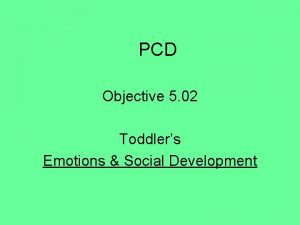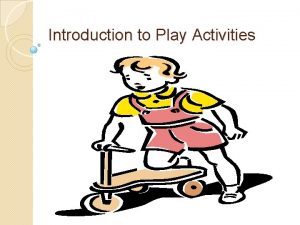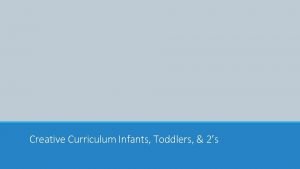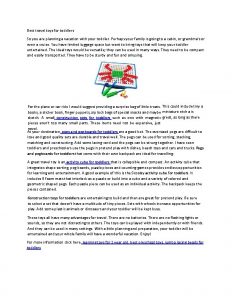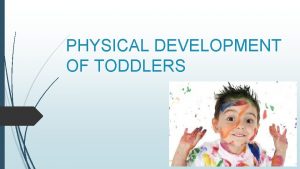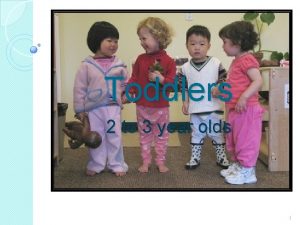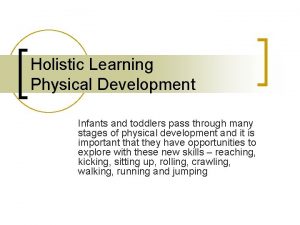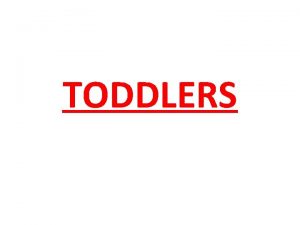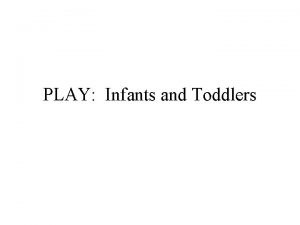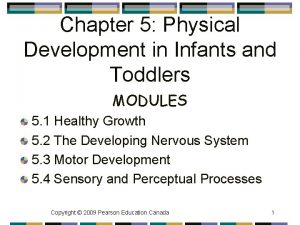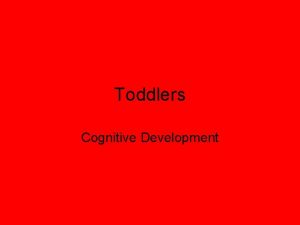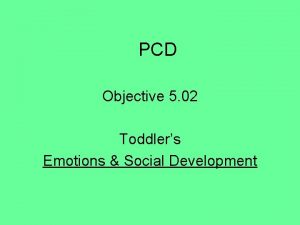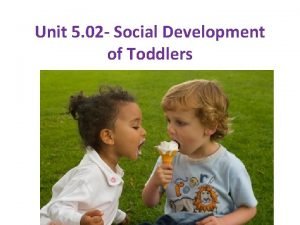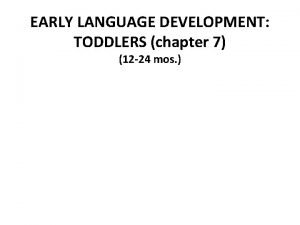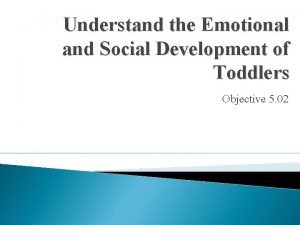The Physical Development of Toddlers Physical DevelopmentToddlers Physical




















- Slides: 20

The Physical Development of Toddlers

Physical Development—Toddlers • Physical Growth slows considerably after the first year • Physical skills continue to improve dramatically from the 1 st year to age 4 • The term toddlers refers to children who toddle or make uncertain movements • 3 -year-olds can walk steadily, hop, jump and run • These children need lots of space and time each day for active play so they can exercise their muscles and use up their stored energy • Their attention span is longer than infants but they still like to change games and activities often

Height & Weight • Growth in height and weight is slower during this period than among infants • From age 1 to 3 children gain only about ½ pound per month • Growth slows by about half • Hereditary and environment influence height and weight • After the 1 st birthday children begin to show variation in size. A tall 2 year old is usually a tall adult

Proportion & Posture • Until age 2, a child’s head, chest and abdomen measure about the same size and grow at the same rate • By age 3 the chest becomes larger than the head and abdomen. During this time the legs and arms grow rapidly • These changes in proportion help improve the child’s balance and motor skills

Teeth • One year olds have an average of 8 teeth although there is great variation among children. • Back teeth (molars) usually emerge early in the third year. • Once all toddlers teeth are in they have 20 primary teeth. • Quality of their teeth is influenced by their diet during the first 2 years and their mother’s diet during pregnancy. • Diary products which are rich in calcium and phosphorus are especially important. • Vitamin D in milk helps build strong healthy teeth and bones. • Avoid giving children sweets which can cause teeth decay. • Avoid putting a child to bed with a bottle unless it contains water. • Heredity appears to play a role in tooth quality.

Motor Skills • Large motor skill use is improving during the toddler stage. Large muscles include those in the arms, legs and back. • Small motor skill use of the hands and fingers will become more refined during the preschool years. • Increased Skills – At 13 months a child can bang blocks together or stack two or three of them – By age 4 they can use the blocks to make high towers, houses and roads

2 Types of Motor Skills • Large Motor Skills – Use of the large muscles of the back, legs, shoulders and arms Walking, Running and Throwing Balls • Small Motor Skills – Finer muscles of the wrists, fingers and ankles. Using a crayon or paintbrush to turning pages of books and eating – require hand-eye-coordination. This is the ability to move the hands precisely. – Physical Skills aren’t predictable as in the first year. Some skills are earlier than average and others later than average. These variations can be caused by differences in physical size, health and diet, interests, temperament, and opportunities for physical play. – Developmentally appropriate tasks that are suitable for children given their age and interests.

Large Motor Skills • Physical exercise and repeated practice promote the development of large motor skills. • Most children begin to walk by their first birthday. – The toddler walks by holding on to furniture and is wobbly with toes pointed outward and arms held out for balance. – Climbing upstairs first on their hands and knees and they slide backwards when going down. Then they begin walking with help by placing both feet on each step. Then they go up and down by holding on to the railing.

Small Motor Skills • Between the 1 st and 2 nd birthday, children learn to feed themselves and drink from a cup. Hand-eye coordination causes many spills however with practice their neatness improves. • Two-year-olds show improvement of their dexterity or skillful use of their hands and fingers. – They can turn the pages of a book one at a time, peel a banana and turn on a faucet. – They enjoy using crayons, building with blocks. • Three-year-olds show considerably more skill. – They take things apart and put them back together – Their drawing improves as they can draw circles, horizontal and vertical line and even a cross.

Caring for toddlers • By their first birthday children are already beginning to do things for themselves. If they are encouraged to practice, three-year-olds can dress, eat, brush teeth, and go to the bathroom independently.

Feeding • Habits and attitudes toward food that children learn at this stage will influence their food habits throughout their life. – Self-feeding helps improve their small motor skills. – Children are growing less rapidly than in their first year of life - these children don’t eat at much. – Most do need food every 3 to 4 hours because their stomachs are small. The amount they eat varies greatly day to day depending upon appetite and level of activity. – Meals become a battle of wills between caregivers and children as many food likes and dislikes are developed. • Children accept new foods more easily if they aren’t pressured to or rewarded for eating them.

Feeding Skills Improve • 1 year olds still eat a variety of finger foods that are easily picked up and eaten. Around 18 months of age is when children begin using a spoon. • 2 year olds can usually feed themselves and learn to use a fork. Be patient as they often take a long time to eat. Eating helps promote motor skills. • 3 Year olds have a full set of primary teeth so chewing foods is not a problem although tough foods should served in small pieces.

Choosing Foods • Provide a variety of nutritious foods • Pediatricians recommend that milk or milk products not be given until a child’s 1 st birthday. – 1 to 2 years old--Whole milk – 2 years old--reduced fat milk or low-fat milk • To promote interest in nutritious foods give children appealing meals.

Mealtime Tips • • Include children in food preparation Follow a regular schedule for meals/snacks Use unbreakable dishes, plates and cups Choose a cup the child can hold Provide child size eating utensils Toddler should sit in a a high chair Toddlers imitate others, set good examples

Bathing • Caregivers need to help children develop good hygiene or personal cleanliness • When toilet training, children should be taught to wash their hands each time they use the bathroom. • Routine evening baths are enjoyable part of getting ready for bed. – Bathtubs are still dangerous for children, you should never leave a child alone in the bathtub.

Caring for the Teeth • Teach children to brush their teeth right after eating. The longer foods remains in the mouth the more it can damage the teeth. • Encourage teeth brushing by giving them a toothbrush and little toothpaste. – Children will still need adult help – Dentists recommend that parents begin flossing the child’s teeth and showing the child how to use dental floss.

Dressing • Children are eager to learn dressing skills. – Parents/caregivers should encourage self dressing. • Dressing involves a number of large and small motor skills that must be learned one step at a time. • Patience and practice are important • Children usually start to help with dressing about 13 to 14 months by holding out an arm. • By age three the child can dress independently except for some buttons and shoelaces.

Choosing Clothing • Comfort – Freedom of movement • Durability – Must withstand hard wear and repeated washing. • Synthetic Fibers – are made from chemicals rather than natural sources (polyester and acrylic) are durable, wrinkle resistant and quick drying. Cotton and synthetic blends are best. • Economy – Children outgrow their clothes often. Used clothes, hand me downs, yard sale finds, second hand stores and thrift shops. • Choose clothes that allow for growth.

Sleeping • By their 2 nd birthday sleeping habits of most children change. They usually require less sleep than before and they may not want to go to sleep as easily or willingly. • By age 2 most children no longer take a morning nap. Most 3 year olds give up their afternoon nap as well. • Many 2 year olds many call a parent back repeatedly at bedtime. For a drink of water, they need covers or their stuffed animal). – 3 year olds may awake in the middle of the night. – Some are afraid of the dark (night light) • Children need patients – ridicule or shaming only make the problem worse.

Toilet Training • Many children begin toilet training sometime after 18 months of age. – There is no set age when the process should begin – Each child should start toilet training when he or she is physically mature and emotionally ready. • Readiness – Children must be able to recognize the body sensations that precede elimination. – Being emotionally ready means the child is happily settled into a familiar daily routine. • Giving Help – have a good attitude when toilet training. Calm encouragement is more effective then rules and punishment. It also helps build self-esteem. – After toilet training accidents may still occur – Some may want to use a special child seat. • Training Pants – heavy absorbent underpants in place of diapers are often used while potty training. • Some children recognize that wearing underwear instead of diapers as a sign of maturity.
 Goals of socialization
Goals of socialization Definition of play
Definition of play Creative curriculum for infants and toddlers
Creative curriculum for infants and toddlers Amebiasis symptoms
Amebiasis symptoms Milk for toddlers with milk allergynon dairy
Milk for toddlers with milk allergynon dairy Best travel toys for toddlers
Best travel toys for toddlers Night terrors in toddlers
Night terrors in toddlers Toddler fever
Toddler fever Negativism in toddlers
Negativism in toddlers Hình ảnh bộ gõ cơ thể búng tay
Hình ảnh bộ gõ cơ thể búng tay Bổ thể
Bổ thể Tỉ lệ cơ thể trẻ em
Tỉ lệ cơ thể trẻ em Voi kéo gỗ như thế nào
Voi kéo gỗ như thế nào Thang điểm glasgow
Thang điểm glasgow Chúa yêu trần thế
Chúa yêu trần thế Các môn thể thao bắt đầu bằng tiếng nhảy
Các môn thể thao bắt đầu bằng tiếng nhảy Thế nào là hệ số cao nhất
Thế nào là hệ số cao nhất Các châu lục và đại dương trên thế giới
Các châu lục và đại dương trên thế giới Công thức tính độ biến thiên đông lượng
Công thức tính độ biến thiên đông lượng Trời xanh đây là của chúng ta thể thơ
Trời xanh đây là của chúng ta thể thơ
